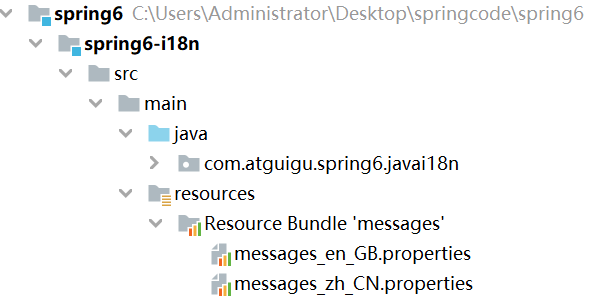9、国际化:i18n

9.1、i18n概述
国际化也称作i18n,其来源是英文单词 internationalization的首末字符i和n,18为中间的字符数。由于软件发行可能面向多个国家,对于不同国家的用户,软件显示不同语言的过程就是国际化。通常来讲,软件中的国际化是通过配置文件来实现的,假设要支撑两种语言,那么就需要两个版本的配置文件。
9.2、Java国际化
(1)Java自身是支持国际化的,java.util.Locale用于指定当前用户所属的语言环境等信息,java.util.ResourceBundle用于查找绑定对应的资源文件。Locale包含了language信息和country信息,Locale创建默认locale对象时使用的静态方法:
/**
* This method must be called only for creating the Locale.*
* constants due to making shortcuts.
*/
private static Locale createConstant(String lang, String country) {
BaseLocale base = BaseLocale.createInstance(lang, country);
return getInstance(base, null);
}(2)配置文件命名规则:
basename_language_country.properties
必须遵循以上的命名规则,java才会识别。其中,basename是必须的,语言和国家是可选的。这里存在一个优先级概念,如果同时提供了messages.properties和messages_zh_CN.propertes两个配置文件,如果提供的locale符合en_CN,那么优先查找messages_en_CN.propertes配置文件,如果没查找到,再查找messages.properties配置文件。最后,提示下,所有的配置文件必须放在classpath中,一般放在resources目录下
(3)实验:演示Java国际化
第一步 创建子模块spring6-i18n,引入spring依赖

第二步 在resource目录下创建两个配置文件:messages_zh_CN.propertes和messages_en_GB.propertes

第三步 测试
package com.javaxiaobear.spring6.javai18n;
import java.nio.charset.StandardCharsets;
import java.util.Locale;
import java.util.ResourceBundle;
public class Demo1 {
public static void main(String[] args) {
System.out.println(ResourceBundle.getBundle("messages",
new Locale("en","GB")).getString("test"));
System.out.println(ResourceBundle.getBundle("messages",
new Locale("zh","CN")).getString("test"));
}
}9.3、Spring6国际化
9.3.1、MessageSource接口
spring中国际化是通过MessageSource这个接口来支持的
常见实现类
ResourceBundleMessageSource
这个是基于Java的ResourceBundle基础类实现,允许仅通过资源名加载国际化资源
ReloadableResourceBundleMessageSource
这个功能和第一个类的功能类似,多了定时刷新功能,允许在不重启系统的情况下,更新资源的信息
StaticMessageSource
它允许通过编程的方式提供国际化信息,一会我们可以通过这个来实现db中存储国际化信息的功能。
9.3.2、使用Spring6国际化
第一步 创建资源文件
国际化文件命名格式:基本名称 _ 语言 _ 国家.properties
{0},{1}这样内容,就是动态参数

(1)创建javaxiaobear_en_US.properties
www.javaxiaobear.com=welcome {0},时间:{1}(2)创建javaxiaobear_zh_CN.properties
www.javaxiaobear.com=欢迎 {0},时间:{1}第二步 创建spring配置文件,配置MessageSource
<?xml version="1.0" encoding="UTF-8"?>
<beans xmlns="http://www.springframework.org/schema/beans"
xmlns:xsi="http://www.w3.org/2001/XMLSchema-instance"
xsi:schemaLocation="http://www.springframework.org/schema/beans http://www.springframework.org/schema/beans/spring-beans.xsd">
<bean id="messageSource"
class="org.springframework.context.support.ResourceBundleMessageSource">
<property name="basenames">
<list>
<value>javaxiaobear</value>
</list>
</property>
<property name="defaultEncoding">
<value>utf-8</value>
</property>
</bean>
</beans>第三步 创建测试类
package com.javaxiaobear.spring6.javai18n;
import org.springframework.context.ApplicationContext;
import org.springframework.context.annotation.AnnotationConfigApplicationContext;
import org.springframework.context.support.ClassPathXmlApplicationContext;
import java.util.Date;
import java.util.Locale;
public class Demo2 {
public static void main(String[] args) {
ApplicationContext context = new ClassPathXmlApplicationContext("beans.xml");
//传递动态参数,使用数组形式对应{0} {1}顺序
Object[] objs = new Object[]{"javaxiaobear",new Date().toString()};
//www.javaxiaobear.com为资源文件的key值,
//objs为资源文件value值所需要的参数,Local.CHINA为国际化为语言
String str=context.getMessage("www.javaxiaobear.com", objs, Locale.CHINA);
System.out.println(str);
}
}